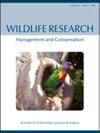Carcass use by mesoscavengers drives seasonal shifts in Australian alpine scavenging dynamics
IF 1.6
3区 生物学
Q3 ECOLOGY
引用次数: 1
Abstract
ABSTRACT Context. Carrion is a high-energy and nutrient-rich resource that attracts a diverse group of vertebrate scavengers. However, despite the carrion pool being highly seasonal in its availability, there is little understanding of how scavengers utilise carcasses across all four seasons. Aims. To assess how season influences carcass-detection times by vertebrate scavengers and their rates of scavenging. Methods. We used remote cameras to monitor vertebrate scavenging at 15 eastern grey kangaroo (Macropus giganteus) carcasses in four consecutive seasons (summer, autumn, winter, and spring; total 58 carcasses) in the Australian Alps. Key results. In total, 745 599 remote-camera images were captured, within which 34 vertebrate species were identified, nine of which were recorded to actively scavenge. Time to first detection of carcasses by vertebrate scavengers was 5.3 and 9.6 times longer during summer (average 144 h) than during spring (average 34 h) and winter (average 24 h) respectively. Rates of vertebrate scavenging were highest in winter and spring, with brushtail possums (Trichosurus vulpecula) accounting for 78% of all scavenging events during winter, and ravens (Corvus spp.) accounting for 73% during spring. High rates of carcass use by these mesoscavengers may reflect a scarcity of other food sources, the demands of their breeding season, or a relative absence of scavenging by larger dominant species such as dingoes (Canis dingo) and wedge-tailed eagles (Aquila audax). Conclusions. These findings demonstrate the highly seasonal nature of vertebrate scavenging dynamics in an alpine ecosystem, and that mesoscavengers, not apex scavengers, can dominate the use of carcasses. Implications. Accounting for the effects of season is integral to understanding the way animals utilise carcasses in alpine and other strongly seasonal environments; and for developing further our knowledge of ecosystem processes linked to decomposition.中食腐动物的尸体利用驱动了澳大利亚高山食腐动态的季节性变化
本文章由计算机程序翻译,如有差异,请以英文原文为准。
求助全文
约1分钟内获得全文
求助全文
来源期刊

Wildlife Research
生物-动物学
CiteScore
4.30
自引率
15.80%
发文量
56
审稿时长
3 months
期刊介绍:
Wildlife Research represents an international forum for the publication of research and debate on the ecology, management and conservation of wild animals in natural and modified habitats. The journal combines basic research in wildlife ecology with advances in science-based management practice. Subject areas include: applied ecology; conservation biology; ecosystem management; management of over-abundant, pest and invasive species; global change and wildlife management; diseases and their impacts on wildlife populations; human dimensions of management and conservation; assessing management outcomes; and the implications of wildlife research for policy development. Readers can expect a range of papers covering well-structured field studies, manipulative experiments, and analytical and modelling studies. All articles aim to improve the practice of wildlife management and contribute conceptual advances to our knowledge and understanding of wildlife ecology.
Wildlife Research is a vital resource for wildlife scientists, students and managers, applied ecologists, conservation biologists, environmental consultants and NGOs and government policy advisors.
Wildlife Research is published with the endorsement of the Commonwealth Scientific and Industrial Research Organisation (CSIRO) and the Australian Academy of Science.
 求助内容:
求助内容: 应助结果提醒方式:
应助结果提醒方式:


